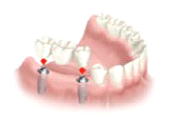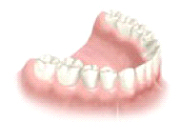Dental Implants
What are dental implants?

A dental implant is a structure that replaces a missing tooth. With screw-like devices, the surgeon inserts an implant into the jawbone, and it acts as an anchor for an artificial tooth, called a crown. A device called an abutment connects the artificial tooth to the dental implant. The crown is custom-made to fit the person’s mouth and match the colour of their teeth. Crowns look, feel, and function like natural teeth.

DENTAL IMPLANT - SINGLE TOOTH IMPLANTS
Single Tooth Implants

Single-tooth implants can be used in people who have missing one or more teeth. An implant is surgically placed in an opening that is made by your dentist in the jawbone. After the implant integrates (attaches) to your bone, it acts as a new “root” for the crown that will be replacing your missing tooth. A crown (cap), which is made to look like a natural tooth, is attached to the implant and fills the space left in the mouth by the missing tooth.
For this procedure to work, there must be enough bone in the jaw, and the bone has to be strong enough to hold and support the implant. If there is not enough bone, be may need to be added with a procedure called bone augmentation. In addition, natural teeth and supporting tissues near where the implant will be placed must be in good health.
Single Tooth Implant Treatment Procedure

1: Before the procedure
The dentist makes a first examination and takes one or more x-rays of the area to prepare for the procedure.

2: Installing the implant
The implant is placed. At this time, a temporary tooth will be provided that allows you to eat and function like normal almost immediately. The implant will need a few months to integrate with the jawbone before the next step is taken.

3: Attaching the new crown
The final step is the placement of the permanent ceramic tooth. The new tooth is installed for life. No additional treatment is needed.

4: End result
You should expect the new tooth to fit and function just like a natural tooth. Do your usual dental hygiene to keep the tooth and gum around it clean.
DENTAL IMPLANT - MULTIPLE TEETH IMPLANTS
Multiple Teeth Implants
Just as with one missing tooth, several missing teeth can be easily treated with dental implants. Implant supported teeth are permanently fixed in the mouth, unlike removable appliances like dentures. They don’t slip or click, and there is no worry about them moving or falling out when speaking, eating, or participating in activities. And because dental implants are placed directly into the bone, they help preserve the jawbone and prevent bone deterioration.
Don’t ignore missing back teeth losing multiple tooth from decay, gum disease or neglect will have a domino effect resulting in bone loss around your remaining teeth causing them to become loose, rotated and mobile. Don’t be complacent just because your missing teeth are in the back of your mouth! To avoid the risk of cascading harm to neighbouring teeth, your lost teeth should be replaced as soon as possible with implants.

Multiple Tooth Implant Treatment Procedure

1: Before the procedure
The dentist makes a first examination and takes one or more x-rays of the area to prepare for the procedure.

2: Installing the implant
Titanium tooth implant bases are placed into the jawbone to replace the job of the roots. We allow a period of time for the jawbone to heal over the bases before fitting for a crown.

3: Attaching the new crown
After healing, the abutments are attached to the dental implants. These components are used to hold custom-made ceramic crowns that the dental laboratory will mould and match to your existing teeth.

4: End result
Finally custom fabricated crowns are placed over the tooth implant abutments and will function like a real tooth.
DENTAL IMPLANT – MISSING ALL TEETH
Full mouth dental implants



Can just four implants replace all of the teeth on the top or the bottom of your mouth? Thanks to advances in dental implant technology, that answer is a resounding yes.
Believe it or not, tooth loss is extremely common among adults, especially as we age. One quarter (26%) of adults aged 65 or older have 8 or fewer teeth. About 1 in 6 (17%) adults aged 65 or older have lost all of their teeth. Living with the discomfort and hassles of dentures, many people are opting for what is called full mouth dental implant restoration.
One full arch of teeth, four dental implants
To fully understand this remarkable technique for replacing teeth, you should first understand what a dental implant is. An implant is a small titanium screw that fits inside your jawbone and replaces the root-part of a missing tooth. Minor surgery is required to insert the implants. Once the implant is in place, a crown is attached to give you a highly realistic-looking and functional prosthetic tooth.
Here’s where it gets really interesting: You do not need a dental implant for each and every one of your missing teeth. All you need is four precisely placed implants on the top of your mouth, and four on the bottom, to restore your full smile. That’s the beauty of the full arch. And because the implant is made of titanium, it has the unique ability to fuse to living bone and function as part of it. So eventually, the dental implant becomes part of the jawbone and serves as a strong, long-lasting foundation for your new teeth.
Besides ensuring that your implants are permanently fixed in place, this bone fusion has another important benefit: it can prevent future bone loss in the jaw. This helps to maintain a more youthful facial structure—and better oral health. But perhaps the biggest surprise about the full arch is how quickly it can transform your life.
Frequently Asked Questions related to Full Mouth Dental Implants
- Endosteal: These dental implants are placed in the jawbone. Typically made of titanium and shaped like small screws, they are the most commonly used type of implant.
- Subperiosteal: These dental implants are placed under the gum but on or above the jawbone.

